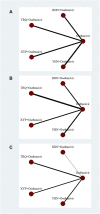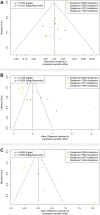Traditional Chinese Medicine Injections Combined With Oseltamivir for Influenza: Systematic Review and Network Meta-Analysis
- PMID: 35935865
- PMCID: PMC9355026
- DOI: 10.3389/fphar.2022.848770
Traditional Chinese Medicine Injections Combined With Oseltamivir for Influenza: Systematic Review and Network Meta-Analysis
Abstract
Background: As a cause of respiratory tract infections in humans, influenza remains with high morbidity and mortality, with associated significant healthcare burden and increased financial burden. Traditional Chinese medicine injections (TCMIs) combined with oseltamivir (TCMIs + oseltamivir) are the representative therapeutic strategies for influenza, which is a compliant with clinical applications in China. The aim of this study was to describe the comparative efficacy and safety of TCMIs + oseltamivir in patients with influenza, based on the current evidence. Methods: PubMed, Embase, Cochrane Library, Web of Science, China National Knowledge Infrastructure, Wanfang Data Knowledge Service Platform, VIP information resource integration service platform databases, and the Chinese biomedical literature service system were searched to find randomized controlled trials where TCMIs + oseltamivir are the representative therapeutic strategies for influenza, from inception until October 2021, without language restriction. Two investigators independently screened eligibility criteria, extracted data, and appraised the risk of bias with the same criteria. We conducted a network meta-analysis using the Bayesian random method for each outcome and performed the sensitivity analysis, meta-regression, and Egger's and Begg's tests for the reliability and robustness of our results. Results: Thirty-one trials including 2,893 participants proved eligible and reported on four TCMIs + oseltamivir versus oseltamivir. Network meta-analysis showed Yanhuning (YHN) +oseltamivir (MD = -1.7, 95% CrI: -2.5 to -0.88; SUCRA = 0.89; low certainty of evidence) in fever disappearance time, Tanreqing (TRQ) +oseltamivir (MD = -1.9, 95% CrI: -2.8 to -1; SUCRA = 0.97; low certainty of evidence) in cough disappearance time, and Xiyanping (XYP) +oseltamivir (OR = 5.9, 95% CrI: 3.1 to 11; SUCRA = 0.82; very low certainty of evidence) in the response rate to be more efficacious than oseltamivir alone with the best SUCRA. Based on the combined SUCRA value for primary outcomes, TRQ + oseltamivir is probably better in cough disappearance time, and XYP + oseltamivir and YHN + oseltamivir may be better in fever disappearance time than others. No significant difference in safety between the treatments. Conclusion: In patients with influenza, TCMIs + oseltamivir only partially improve flu symptoms. Overall therapeutic efficacy and safety are inconclusive, based on low to very low certainty of evidence. However, the safety remains uncertain, and TCMI treatments for influenza should be considered with caution. More high-quality studies examining the efficacy and safety of TCMIs are needed. Systematic Review Registration: https://www.crd.york.ac.uk/PROSPERO/, identifier CRD42021286994.
Keywords: antiviral drug in Chinese herbal medicine; clinical evidence; influenza; network meta-analysis; oseltamivir; systematic review; traditional Chinese medicine injections.
Copyright © 2022 Peng, Chen, Li, Han, Sun, Li, Wu, Chen and Li.
Conflict of interest statement
The authors declare that the research was conducted in the absence of any commercial or financial relationships that could be construed as a potential conflict of interest.
Figures





Similar articles
-
Traditional Chinese Medicine Injections Combined With Antihypertensive Drugs for Hypertensive Nephropathy: A Network Meta-Analysis.Front Pharmacol. 2021 Oct 22;12:740821. doi: 10.3389/fphar.2021.740821. eCollection 2021. Front Pharmacol. 2021. PMID: 34744724 Free PMC article. Review.
-
Comparative efficacy of seven Chinese patent medicines for early diabetic kidney disease: A Bayesian network meta-analysis.Complement Ther Med. 2022 Aug;67:102831. doi: 10.1016/j.ctim.2022.102831. Epub 2022 Apr 7. Complement Ther Med. 2022. PMID: 35398481 Review.
-
Traditional Chinese Medicine Oral Liquids Combined With Azithromycin for Mycoplasma pneumoniae Pneumonia in Children: A Bayesian Network Meta-Analysis.Front Pharmacol. 2021 May 28;12:652412. doi: 10.3389/fphar.2021.652412. eCollection 2021. Front Pharmacol. 2021. PMID: 34122075 Free PMC article. Review.
-
Efficacy of Chinese Herbal Injections for Elderly Patients With pneumonia-A Bayesian Network Meta-analysis of Randomized Control Trials.Front Pharmacol. 2021 May 21;12:610745. doi: 10.3389/fphar.2021.610745. eCollection 2021. Front Pharmacol. 2021. PMID: 34093171 Free PMC article.
-
Efficacy and Safety of TCMI in Patients With Combined Coronary Heart Disease and Heart Failure: A Systematic Review and Network Meta-Analysis.Front Pharmacol. 2021 Nov 23;12:741261. doi: 10.3389/fphar.2021.741261. eCollection 2021. Front Pharmacol. 2021. PMID: 34899296 Free PMC article. Review.
Cited by
-
Traditional Chinese Medicine for Viral Pneumonia Therapy: Pharmacological Basis and Mechanistic Insights.Int J Biol Sci. 2025 Jan 6;21(3):989-1013. doi: 10.7150/ijbs.105086. eCollection 2025. Int J Biol Sci. 2025. PMID: 39897040 Free PMC article. Review.
-
Effects of Tanreqing injection on the gut microbiota in healthy volunteers.Front Cell Infect Microbiol. 2024 Oct 4;14:1428476. doi: 10.3389/fcimb.2024.1428476. eCollection 2024. Front Cell Infect Microbiol. 2024. PMID: 39431053 Free PMC article.
-
A neuraminidase-based electrochemical biosensor for high-throughput screening of antiviral compounds in traditional Chinese medicine.Mikrochim Acta. 2025 May 27;192(6):378. doi: 10.1007/s00604-025-07203-z. Mikrochim Acta. 2025. PMID: 40425963
References
Publication types
LinkOut - more resources
Full Text Sources
Research Materials

